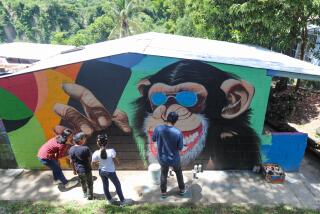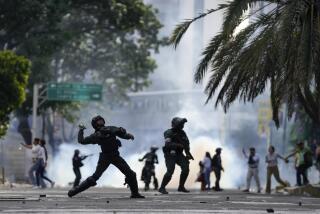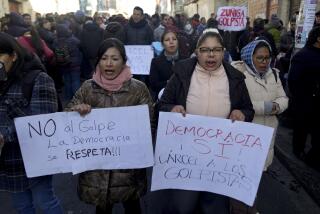A Military Menace Hides Behind Latin America’s New Democracy
PALO ALTO — The story last month in Hoy, Bolivia’s principal daily newspaper, conveyed the usual:
“After a 10-day hunger strike, 100 miners, factory workers and students marched peacefully to Cochabamba’s principal square. The procession ended violently when baton-swinging government soldiers lobbed tear-gas shells into their ranks, dispersing the pale and hungry protesters. Women and children were among those most affected.”
In Colombia, civilians suspected of leftist activities “disappear” or are openly murdered in increasing numbers. Amnesty International reports, “Death squads, some in uniform and some in civilian clothes travel in Army vehicles and in unmarked cars without license plates, pass freely through Army roadblocks, park in police compounds and military installations and have been seen handing over prisoners at military bases and barracks.”
Such events are routine in old-style, stereotypical Latin American dictatorships. But Bolivia is supposed to be different, one of the heralded “new” democracies on a continent where decades of tyranny reportedly are being replaced by freedom. And Colombia has long been considered a democratic bastion, with a history of legitimately elected governments.
Democracy, whatever its form, comes no more fragile than in Latin America.
Like a disease that lay dormant for a short while, an epidemic of military-directed repression is infecting many Latin countries. This time, however, it appears to be more sinister than in past decades, when dictatorships were the norm. The new repression is hidden by military leaders behind a cloak of respect for democracy and support for weak but pliable elected governments.
Sometimes Latin military repression can even extend beyond the continent’s borders. The two respected Colombian journalists detained in the United States in the past month because of their alleged Communist connections had already experienced problems with the Colombian Army.
Patricia Lara and Olga Behar had both written books critical of the Army’s anti-guerrilla activities. Their names had been blacklisted by the military, and Behar was forced to flee to Mexico earlier this year, hours before soldiers broke into her apartment. Under pressure from the press, then-President Belisario Betancur admitted he had been unaware of the Army’s action.
Ironically, Betancur’s protests of ignorance have been echoed in the last several weeks by the present administration. The foreign ministry claims to be puzzled by U.S. accusations that Lara is active in the M-19 guerilla movement and linked to the Cuban secret police. Colombia’s elected leaders don’t know where such information comes from.
As in Colombia and Bolivia, democratically chosen governments in Peru, Argentina, Guatemala, El Salvador, Panama and Uruguay try to rule under the menacing jackboot of their respective armies.
Even Peruvian President Alan Garcia, elected by an overwhelming majority of his countrymen, has failed to escape military dominance. In July, according to the Wall Street Journal, “Garcia was so nervous about the possibility of a military coup that he sought support from the U.S. and the democratic governments in South America.”
The reason for his alarm: fear among Peru’s generals that they would be blamed for the June 19 slaughter of 240 leftist rebel inmates in three prisons. The threat of a coup was a warning to Garcia--that his power has limits and he better not overstep them.
In Argentina, ongoing trials of military leaders, for crimes committed during their seven-year reign until elections in 1983, led people to believe that things finally would be different. They were wrong; Argentine military officers are hardly repentant--about either their dismal defeat in the Falklands Islands or their mishandling of domestic policies.
“The . . . armed forces don’t criticize themselves because they are completely convinced that they acted correctly, that they saved the country,” Juan-Carlos Pugliere, president of the Chamber of Deputies, said recently.
When President Raul Alfonsin inspected the Army’s Third Corps in June, his security men discovered a bomb inside the garrison his entourage was to visit. Political analysts interpreted the near-assassination as a reminder from the military of its ability to influence government.
Central American countries are still more obvious examples of the devolution from democracy. El Salvador and Guatemala suffer bouts of terror as paramilitary groups and death squads seize citizensperceived as enemies and then kill them with brutal efficiency. The first 10 months of Vinicio Cerezo’s Christian Democratic government in Guatemala, for example, has produced 234 deaths, 107 “disappearances,” and 341 alleged “kidnappings,” according to that country’s Human Rights Commission.
Panama’s President Eric A. Delvalle--who was never elected but achieved office through the machinations of military strongman Gen. Manuel Antonio Noriega--functions as no more than a figurehead. President-elect Nicolas Ardito Barletta was “set aside” last year when he instigated an investigation of the military following the assassination of a former leftist government official.
Such events in nominally democratic Latin countries undercut the process of “redemocratization” in the 1980s that has been so enthusiastically lauded by the United States and other free nations. In Latin America, democracy too often wears a uniform.
In the 1950s and ‘60s, as the continent experienced social, economic and political modernization, scholars and observers concentrated on what they believed was the twilight of Latin tyrants.
Imposition of military rule and a series of coup d’etats in the 1960s and early ‘70s ended their optimism. Burgeoning dictatorships were assisted by training, arms, and economic help from the United States. The flood of military aid from the United States was prompted by the Cuban Revolution in 1960 and the spread of new leftist guerrilla movements throughout the continent. Most of the military leaders of the 10 coups that occurred at the end of the 1960s received U.S. training.
In the early 1980s, Latin countries sank into one of the gravest recessions of the century, sparking predictions that the continent would have a hard time returning to political health. Yet, many Latin American dictatorships fell during that period.
Many Latin experts came to believe that dictators are unable to rule countries in crisis. Repression, the theory goes, cannot prevent hungry and dissatisfied masses from protesting, no matter the physical danger they face from their governments.
The free world applauded Latin America’s emergence as a democratic stronghold. But recent terror suggests that Latin Americans in many countries now suffer abuses as cruel and unjust as they did under earlier tyranny.
Latin America continues to live a history battered by neologisms: From “redemocratization” toward “reauthoritarianism” under a guise of democracy. While the words change, instability remains constant.
More to Read
Sign up for Essential California
The most important California stories and recommendations in your inbox every morning.
You may occasionally receive promotional content from the Los Angeles Times.










